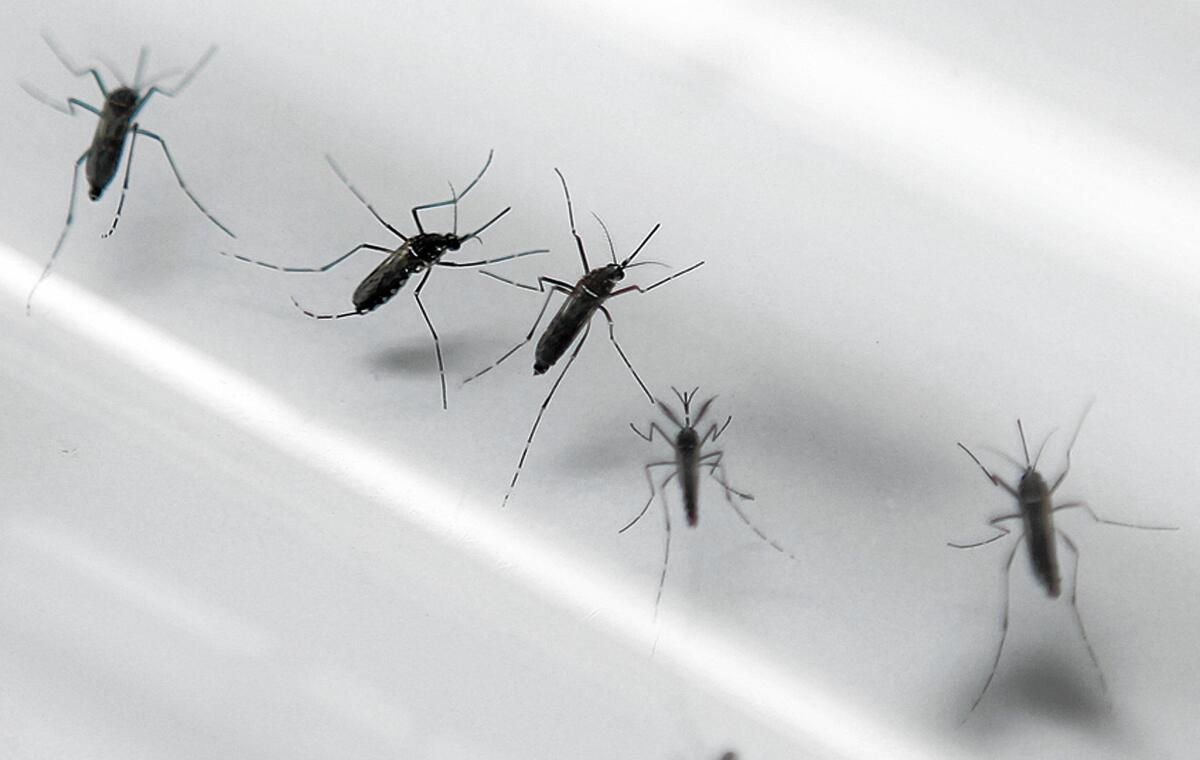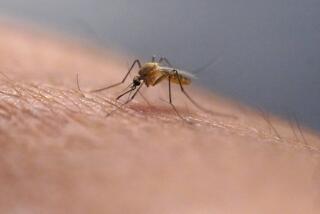Fighting mosquitoes with mosquitoes: Biological weapons target Zika virus

Aedes aegypti mosquitoes transmit Zika virus, which is linked to birth defects.
reporting from JOHANNESBURG, South Africa — As mosquitoes buzzed about on her veranda one recent evening, Maureen Coetzee didn’t reach for bug spray or a swatter. She dashed inside, grabbed a device resembling a drinking straw and sucked four mosquitoes into a specimen jar.
She quickly identified them as Aedes aegypti, the villain in the Zika crisis a continent away.
The next day, in her laboratory at the National Institute for Communicable Diseases, Coetzee peered at her new captives as they squatted in their containers.
To her delight, one had laid eggs, meaning she could breed them.
Coetzee has devoted her life to understanding mosquitoes — in order to kill them.
No other animal has done so much harm to the human race. Each year, they infect millions of people with malaria, yellow fever, dengue fever and other viruses and parasites, killing at least 600,000, the vast majority of them children in Africa. The World Bank estimates that they cost afflicted African countries 1.3% of gross domestic product each year.
Which raises the question: Why not try to wipe mosquitoes off the planet?
Coetzee and other scientists said that would be extreme, given that only about 150 of the 3,500 species of mosquitoes are carriers of deadly pathogens. It would also be wildly impractical to try infiltrating every mosquito breeding ground.
But more thorough control may be possible through a combination of methods. After decades of fighting mosquitoes — and mostly losing — technology is bringing new biological weapons to the battle.
Coetzee, an entomologist at the University of Witwatersrand and international expert on mosquito control, is conducting research on an anti-malaria strategy that involves breeding male mosquitoes, sterilizing them with radiation and releasing them into the wild.
The concept was pioneered in the 1950s when U.S. scientists used it to eradicate the screwworm fly. Applied to mosquitoes, it relies on two basic facts: They mate only once, and only females bite.
The strategy depends on releasing enough mosquitoes to crowd wild males out of the mating game, letting the current generation die out without reproducing. The life span of a mosquito is two to four weeks. Coetzee said that effective control would require releasing millions monthly during malaria season across vast areas.
One advantage of the strategy over other methods is that it allows targeting of individual species of mosquitoes. “It makes sense to target only those mosquitoes that are involved in transmission of disease,” Coetzee explained.
Though she and other scientists have no qualms about trying to eliminate those species, even that goal is “highly unlikely,” she said.
The four species that transmit malaria in Africa breed in rain pools. “If you think about the whole of Africa, you are never going to get to every rain pool,” she said. “Inevitably you will have pockets of mosquitoes.”
“There’s no silver bullet,” she said.
In the long history of the world’s battle against mosquitoes, a central lesson has emerged: Never back off. The moment that authorities scale back control measures or lose track of mosquito population trends, the insects bounce back with a vengeance, and outbreaks of deadly disease inevitably follow.
“Progress on every front and at every level is fragile,” a South African Medical Journal reported in a 2013 article on malaria. “Malaria is a disease that can take full advantage of any lapse in investment, vigilance and control.”
See more of our top stories on Facebook >>
In the 1950s, the World Health Organization launched a malaria eradication campaign that used the insecticide DDT to kill mosquitoes in the United States, Europe, Asia and South America. Malaria seemed to disappear. In South Africa, which conducted its own campaign, government medical research authorities ordered the country’s foremost mosquito expert, Botha De Meillon, to abandon his study of mosquitoes because the malaria problem had been solved.
Malaria, of course, came roaring back.
In 1962, biologist Rachel Carson’s book “Silent Spring” argued that DDT was damaging the environment, especially bird populations, sparking a political movement that led the U.S. to ban the insecticide a decade later. Other countries followed suit, eliminating a powerful if controversial tool for mosquito control.
In 2004, an international agreement, the Stockholm Convention, banned DDT except in certain cases for control of malaria-carrying mosquitoes.
Though other insecticides are widely used, they too have their limits.
Mosquito populations have grown increasingly resistant, a global problem that Coetzee places on par with the rise of bacteria resistant to antibiotics.
Another problem with insecticides is that mosquito breeding sites are easy to miss, said Laith Yakob, a vector control expert at the London School of Hygiene and Tropical Medicine. For example, Aedes aegypti, which carries the Zika virus, is especially hard to reach because it often breeds in houses and can reproduce in thimble-sized pools of water.
“Any of them can be viable breeding sites, and imagining that citywide, it would be impossible to eliminate all breeding sites,” he said. “And even if you did, the next time it rained, they would be back.”
That’s where newer technologies can help.
One of the newest is a variation of the sterilized male strategy. It involves genetically modifying male mosquitoes so their offspring are programmed to die before they mature and are able to reproduce.
Some scientists believe genetic modification is better than sterilization, because dousing mosquitoes with radiation could leave them less vibrant and hurt their ability to compete with their wild counterparts when it comes to mating.
In the months before the Zika outbreak in the Americas, a British company announced that it had conducted a successful trial in the Brazilian city of Piracicaba, cutting the number of mosquito larvae by 82%.
The company, Oxitec, which bills itself as the world’s only genetically modified insect firm, announced last month that it planned to build a facility in Brazil soon to produce genetically modified Aedes aegypti mosquitoes in batches large enough to protect a town of 300,000.
The mosquitoes are puffed out the window of an SUV in bursts of 1,000, and can be directed at hot spots or blanket an entire town. “A male will always find a female,” Oxitec Chief Executive Hadyn Parry said. “A male will find its way into a house.”
Like the sterile insect method, the approach is best used in conjunction with other methods, such as insecticides.
“For us it’s a numbers game,” Parry said. “We need to outnumber the wild males, so the lower the population you have to start with, the quicker and easier it is to get rid of it.”
But the company faces strong opposition from groups like the Britain-based group Gene Watch, which argues genetically modified mosquitoes have no proven benefits and that killing one species may result in another more invasive species filling the vacuum.
Back in Coetzee’s laboratory, thousands of mosquito eggs sat in a tub of water. They were already hatching into the larvae of a species that carries malaria. Gauze-topped vessels lined the walls, some splattered with guinea pig blood that females were fed and had excreted. The males feed on sugar water.
“They’re intriguing little organisms,” said Coetzee, who has been studying mosquitoes for more than 40 years.
“Three and a half thousand species is a lot of variation and some of them are very beautiful,” she said.
To illustrate her point, she took a mosquito she had caught and pinned to a board decades ago and placed it under a microscope: Toxorhynchites brevipalpis, better known as the elephant mosquito. It has a wingspan of almost an inch and a striking blue thorax flecked with gold and fuzzy antennae.
It lives off nectar and doesn’t bite humans.
NEWSLETTER: Get the day’s top headlines from Times Editor Davan Maharaj >>
ALSO
Pope Francis plans a symbolically freighted trip to Mexico
Islamic State-linked fighters seizing oil-rich land in Libya
No VWs for this gang: Bicycling arsonists in Berlin target Mercedes, BMWs and Porsches
More to Read
Sign up for Essential California
The most important California stories and recommendations in your inbox every morning.
You may occasionally receive promotional content from the Los Angeles Times.










